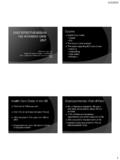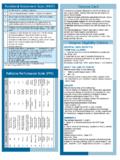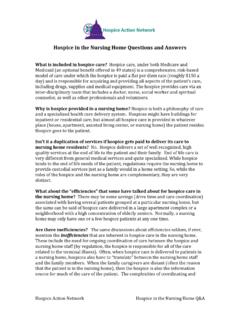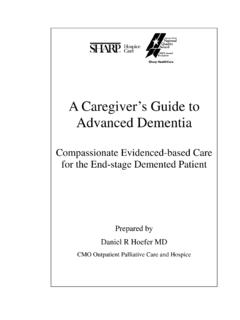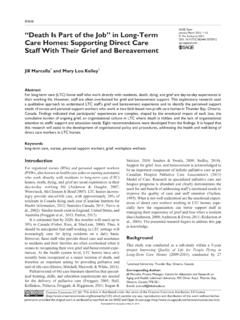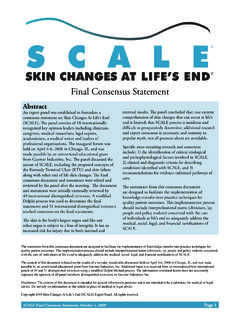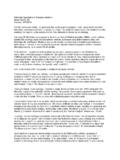Transcription of Hospice Care Regulation: Addressing Seven Areas …
1 2012 CSA RISK MANAGEMENT RESOURCE FOR AGING SERVICESCAREFULLY SPEAKING For many terminally ill patients, Hospice care offers a humane and dignified alternative to conventional medical treatment. It has become an increasingly accepted option for end-of-life care over the past two decades, with approximately million Americans receiving Hospice services from approximately 5,000 programs. These programs operate within a variety of settings, ranging from home care to hospital inpatient units, assisted living facilities and skilled care order to offer consumers greater choice, some Hospice provid-ers have added new services and levels of care , and/or formed partnerships with aging services organizations.
2 However, such ex- pansions and alliances can present providers with new risks, which must be identified and mitigated. One major potential pitfall is failure to adhere to Medicare standards and regulations, which may result in targeted medical reviews, additional documentation requests, claim denials and Medicare National Hospice and Palliative care Organization, 2009, cited at This edition of CareFully Speaking examines Seven common types of administrative and clinical risk exposures associated with Hospice operations:- uninformed benefit election- failure to certify patients as terminally ill- inappropriate level of care - denial of access to services - deficient care planning and related documentation- unsupervised volunteer staff- lack of coordination between Hospice and aging services providers2By implementing measures aimed at improving administrative procedures, clinical documentation, communication and supervi-sion.
3 Hospice providers can enhance their practice in these Seven Areas and better protect patients when they are most vulnerable and in need of compassionate Department of Health and Human services , Office of Inspector General, Model Compliance for Hospice Industry. Available at Access-to- care care -related 1 Hospice care Regulation: Addressing Seven Areas of Major Risk CNA HEALTHPRO, CAREFULLYSPEAKING 2012, ISSUE 1 32 CNA HEALTHPRO, CAREFULLYSPEAKING 2012, ISSUE 1 UNINFoRmEd BENEFIt ELECtIoNMedicare patients elect Hospice care by filing a signed benefit election statement with the Centers for Medicare and Medicaid services (CMS).
4 Securing fully informed consent is of critical impor- tance, as Hospice election represents a sensitive and consequential decision, with a wide range of clinical, ethical and emotional rami- fications. Election statements should minimally contain the follow- ing essential information and disclosures:- a clear explanation of the scope and nature of Hospice services , that treatment is primarily palliative rather than curative- effective date of the election , when Hospice services begin- term of benefits typically two periods of 90 days.
5 Followed by an unlimited number of 60-day periods- waiver of Medicare benefits related to treatment of the terminal illness while enrolled in a Medicare Hospice programElection statements also should reiterate the patient s basic right to change providers or revoke benefits without pressure or undue influence from Hospice administrators or staff. Note that hospital admission alone does not automatically terminate benefits in general, a signed statement from the patient is required to revoke the election for the remainder of the benefit period.
6 Therefore, federal regulators have noted that statements such as the follow-ing serve only to mislead patients:- If I choose care or treatment that has not been preauthorized by the Hospice team or included in the plan, I understand that I have removed myself from the Hospice benefit effective immediately upon my action. - If I choose to be admitted to a hospital that does not have a contract with [named Hospice ], that admission will be considered a decision to revoke my Medicare/Medicaid Hospice benefit election. 33 As cited in the Department of Health and Human services , Office of Inspector General s September 2009 report, Medicare Hospice care for Beneficiaries in Nursing Facilities: Compliance with Medicare Coverage Requirements, at In the event of a legitimate revocation, patients forfeit any remaining days of the election period and Medicare coverage of previously waived benefits ensure clarity and consistency, most organizations adopt a standardized consent form.
7 For a sample Informed Consent and Medicare Benefit Election Form from CMS, visit to CERtIFY PAtIENtS AS tERmINALLY ILLB efore Hospice benefits can commence, the attending physician must certify that the patient has a terminal The certifi-cation process requires physical assessment and a note written in narrative style. Form letters and check-box formats are typically deemed insufficient, because these require only a physician s sig-nature and thus are easily certifications emphasize pain and symptom presentation, as well as interventions and evaluations to date.
8 Certifications should clearly and strongly support a prognosis of six months or less, based on clinical conditions and assessment findings. Vague and inconsistent terms such as continues slow decline, is Hospice -appropriate or needs more care may be subject to misinterpretation and should be regulations stipulate that, in order to establish continued eligibility for benefits, patients who reach the 180-day recertifica- tion date must have a documented face-to-face encounter with a provider no more than 15 days prior to the recertification period.
9 Nurse practitioners may conduct the face-to-face encounter, as long as they certify that their clinical findings were provided to the physician of record. Hospice protocols should reflect these require- ments and administrators should ensure that these encounters are appropriately performed and Attending physician is defined as a doctor of medicine or osteopathy or a nurse practitioner (NP) who is identified by the beneficiary at the time of election as having the most significant role in determining and delivering medical care . However, pursuant to Section 1814(a)(7)(A)(i)(I) of the Social Security Act, an NP may not certify the terminal illness.
10 INAPPRoPRIAtE LEvEL oF CAREThe Medicare Hospice benefit has four levels of care : routine home care , continuous home care , respite care and general inpatient Hospice patients generally decline steadily in their condition from one certification period to the next, but in some cases, con-ditions worsen more quickly than expected or remain temporarily unchanged. When disease progression does not run a normal course, Hospice providers must provide a documented rationale for any change in care level, preferably supported by objective and quantifiable measures.


